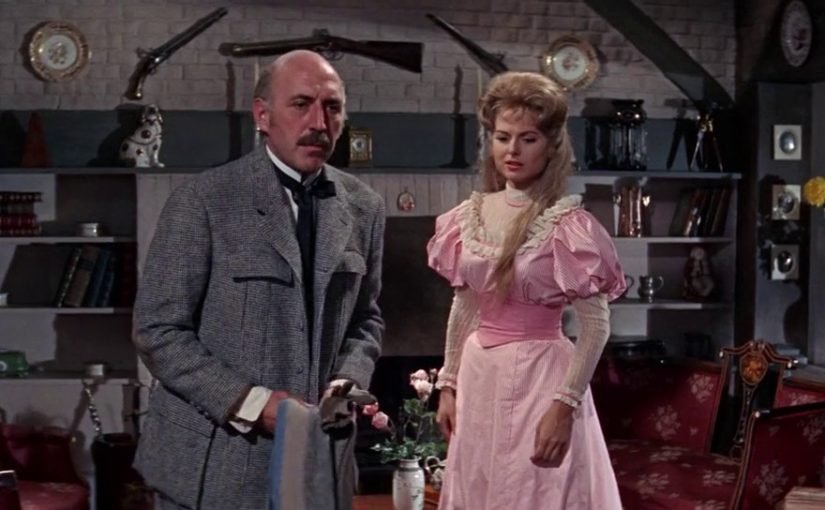Well, here I am. Stuck in the middle of a bioweapons attack. As part of the Trump Trade War, all sorts of germ warfare has been unleashed upon China. This last bout, the coronavirus was the worst. The Chinese military has locked down the entire nation, and drones are keeping everyone inside. Being locked inside is incredibly boring. I mean that there is only so much that you can do, right? So, I’ve been watching some classic science fiction movies…
Today, I would like to chat about a movie titled “First Men on the Moon”. It’s terribly dated, but really… who cares? It’s a charming romp for being locked inside your residence for weeks at a time. I mean, you can only eat so much re-fried rice and drink so much beer, eh?
Based on the HG Wells story. The world is delighted when a space craft containing a crew made up of the worlds astronauts lands on the moon they think for the first time. But the delight turns to shock when the astronauts discover an old British flag and a document declaring that the moon is taken for Queen Victoria proving that the astronauts were not the first men on the moon. On Earth an investigation team finds the last of the Victorian crew - a now aged Arnold Bedford and he tells them the story of how he and his girlfriend Katherine Callender meet up with an inventor Joseph Cavor in 1899. Cavor has invented Cavorite - a paste that will allow anything to deflect gravity and he created a sphere that will actually take them to the moon. Taking Arnold and accidentally taking Katherine they fly to the moon where to their total amazement they discover a bee-like insect population who take an unhealthy interest in their Earthly visitors.
This movie is one of those Saturday-afternoon B-grade classics that I used to watch on snowy Saturday afternoons when I was a kid in the 1960’s. It’s great.
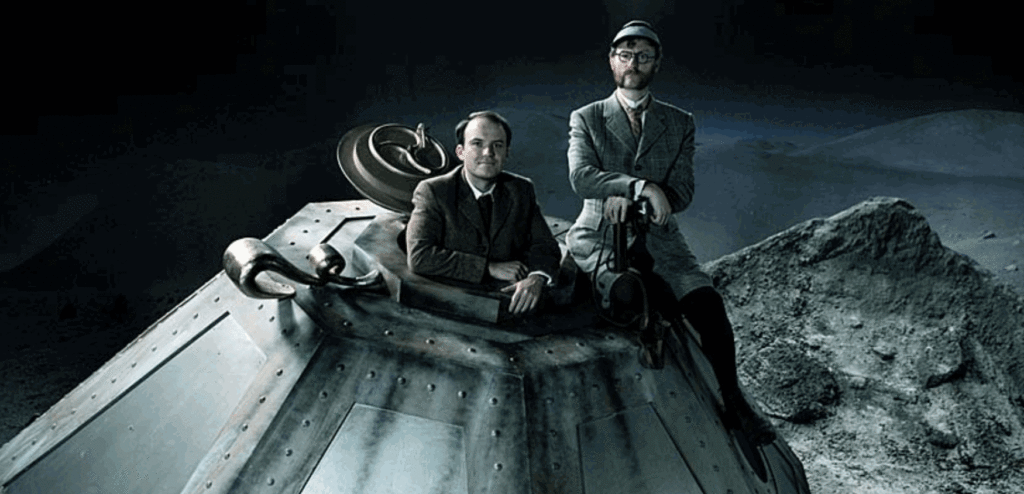
Pedigree
The First Men in the Moon came out a few years after Disney’s adaptation of Jules Verne’s 20,000 Leagues Under the Sea (1954). This had kicked off a spate of period science-fiction classics adapted from Verne, which included the likes of Around the World in 80 Days (1956) and Journey to the Center of the Earth (1959). After George Pal’s successful period adaptation of The Time Machine (1960), other filmmakers turned to the works of Verne’s contemporary H.G. Wells. 20,000 Leagues and The Time Machine remain this cycle’s high points but its downside was that many, if not most, of the films ended as burlesque – Verne had to suffer the increasingly buffoonish likes of the 20th Century Fox Journey to the Center of the Earth, Irwin Allen’s Five Weeks in a Balloon (1962), then Jules Verne’s Rocket to the Moon/Those Fantastic Flying Fools (1967) – and with The First Men in the Moon it was H.G. Wells’s turn. -Moriareviews
H.G. Wells is one of the most revered classic authors of all time. He sits on the Mt. Rushmore of science fiction beside Jules Verne, Isaac Asimov and Ray Bradbury (some would put either Frank Herbert or Arthur C. Clarke ahead of Bradbury, but this is my review, so I call the shots!). Really, I could easily write this entire article about how awesome Ray Bradbury was, but I’ll spare you that indulgence.
Wells wrote many classic works, some of which have been adapted into films to varying degrees of success (The Island of Dr. Moreau, The War of the Worlds, and The Time Machine, to name a few). Is director Nathan Juran’s take on The First Men in the Moon one of the better H.G. Wells adaptations? Not necessarily so. But I think it has its charms and it’s pretty easy to see how it influenced the sci fi genre as a whole.
This 1964 entry was made right smack-dab in the middle of the USA/USSR space race and Cold War. The Vietnam war was picking up steam. Kennedy had been assassinated a year earlier. Definitely a period of tumult and change.
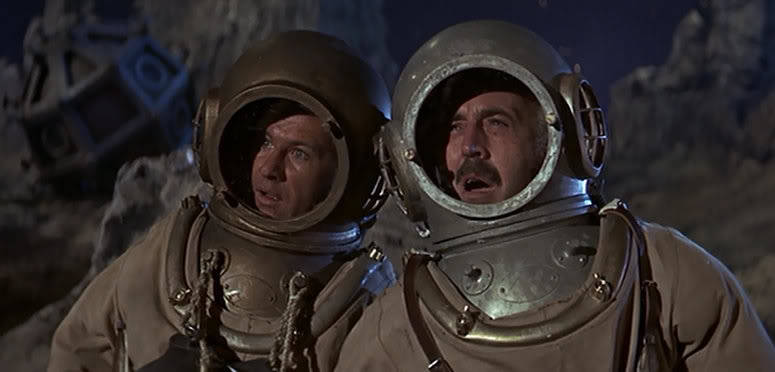
Cinema was going through a renaissance as well, finding its way out of the studio system. However, by the early 60s, with movies struggling to compete with that B&W box in virtually every home, big, bombastic musicals, widescreen auctioneers and family films were the order of the day.
For instance, Mary Poppins came out in 1964, as did My Fair Lady. The Sound of Music would come out a year later, all three among the biggest box-office leaders of the decade.
It was the right time for The First Men in the Moon.

The film starts off with a ship landing on earth. Two U.N. astronauts on a lunar mission casually exit the cockpit and talk to their crew deeper inside the vessel, which sports a set more akin to a modern (i.e.; today) tech-club.
Certainly, the Lunar scenes are good and display a degree of imagination in places – images of vast bubbling cylinders of liquid to generate air, solar lasers and so on. The issues of weightlessness and air and sound in a vacuum are conducted with a little more credibility than most pre-1969 Moon landing science-fiction, although the script has the tendency to bring up the fact that sound does not pass in a vacuum and then ignore it anyway. The cave sets and blending of opticals used to depict the Selenite city are very good too. Harryhausen animates a Moon calf but for time’s sake was forced to abandon the idea of animating most of the Selenties and have them played by children. As a result, the stop-motion creations here count as the most anonymous, least showcasey examples of Ray Harryhausen’s work. The optical effects are variable – while individual model scenes impress, thick matte lines abound and the models ache for the advent of motion control camerawork. -Moriareviews
The movie begins in 1964 with a space ship “United Nations 1” landing on the moon with an international crew.
But once the astronauts de-board the ship, they find out that (record scratch!) they aren’t the first men on the moon.
The people that fear a one world government must be wetting themselves at the thought. As the whole world watches a Russian, an Englishman, and an American leave the ship. I assume that the Englishman and the American are astronauts which mean star voyager while the Russian would be a cosmonaut which means universe voyager.
Anyway, they are poking around and looking at rocks when the Russian cosmonaut, finds a Union Jack flag and a piece of paper claiming the moon in the name of Queen Victoria the 1st who lived from 1837-1901. The paper is dated 1899.
It is very fortunate that the Russian found the paper given the Cold War tension. If the English astronaut found it the other two would have cried foul. They get the paper back to the ship and send it by space fax back to UN HQ. The note is written on a summons for Kate Callender (Martha Hyer) so a multi-national delegation heads to the records office in a quiet English town.
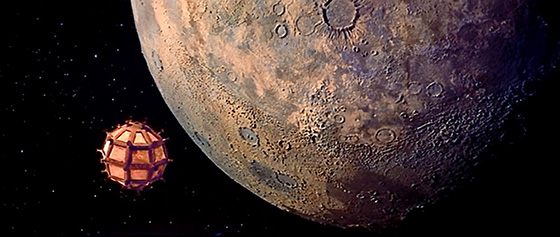
This is all conveniently explained by an aged Arnold Bedford (Edward Judd, a British Sci-fi vet with such big titles to his credit as The Day the Earth Caught Fire and Island of Terror).
According to Bedford, back in 1899, eccentric scientist Joseph Cavor (Lionel Jeffries) and his prim and proper fiancee Kate Callender (Martha Hyer) took an impromptu trip to the moon after a botched attempt at making a pesky batch of “cavorite” (a Wells created anti-gravity “substance.”)
Cavorite.
Hummmm….
Anyways, Cavor is cooking up his anti-gravity paint that he has named Cavorite. Arnold sees the paint working when he is lifted to the ceiling in a chair. After that, Arnold is all in. He will do anything to get a share of the money that is going to be made from Cavorite. He talks about its war applications if it was painted on the bottom of boots. Cavor shows Arnold his moon ship which looks vaguely like a World War II sea mine. He is ready to go on a two person round trip to the moon.
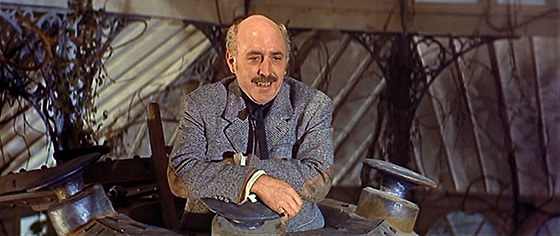
Arnold agrees to sell the cottage he doesn’t own to Cavor. Arnold has Kate sign the papers selling the cottage with a cock and bull story about hiding it from his debtors. Nice boyfriend.
Sometime later Kate is given a summons for fraudulently selling the cottage. She is mad as a hen. Cavor blows the roof off of his house and Kate goes to find Arnold and they make up. She brings them an elephant gun, chickens, and feed.
They accidentally launch in a Jerry-rigged space vessel that resembles a steam-punk billiard room.

This “ship” takes off with Cavor, Arnold, and by accident Kate. Cavor pilots the ship to a moon landing by controlling the Cavorite.
Once they hit the lunar surface…
When the two men are ready to explore they put Kate in an airtight cabinet and they get into deep sea diving suits complete with brass helmets. In the Well’s book, he did not have suits because he wrote that the moon had an atmosphere. This could have been disproven at the time because the moon disk would have a haze around the edge when viewed by a telescope. Their space suits didn’t have gloves and there is much debate about what would happen. Most sites seem to indicate it would cause swelling, pain, and bruising but no long term damage.
The two moonwalkers leave the flag and the note and then discover an insect colony that lives underground on the moon.
Now, this is an alien civilization that looks a heck of a lot like a colony of ants, complete with queen, soldiers, and busy little workers. How they got back home and the results of their journey make up the final act. (So it’s a movie about the moon that doesn’t actually spend much time on the moon. )
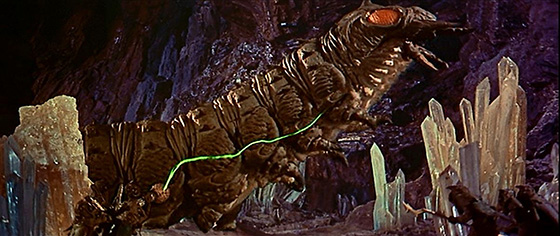
Hence the time first men in not on the moon. Cavor names them Selenites after the Greek moon goddess Selene. The two men escape back to the ship and find that it has been drug underground with Kate still inside.
Yikes!
The two men find the drag trail for the ship and head into the underground bug city to find Kate. They are attacked by a giant caterpillar. The Selenites eventually kill the moon bull with their stun rays. The two earthlings realize that the Selenite city is powered by sunlight that focuses through a large glass panel.

The Selenites begin communicating but they have to power down regularly. Arnold slips away and finds the ship being disassembled by the Selenites. Once the Selenites have learned English they begin having a conversation with Cavor. Cavor thinks its is about the scientific exchange but Arnold thinks they are putting the Earth man on trial. Finally, Cavor is admitted to see the big guy, the Grand Lunar. Arnold tries to get Cavor to escape and in the struggle, the elephant gun is fired at the Grand Lunar. Cavor decides to stay behind in the name of science. Arnold and Kate escape and fly the ship through the glass panels and back to earth.
As Arnold finishes his story he says the ship splashed down near Zanzibar and sank. They never hear from Cavor again.
Back in the present Arnold and the delegation watch the television as
the astro/cosmonauts are breaking into the Selenite city. It is decayed
and there is no life there. They barely escape as the city falls down
around them.
Arnold looks out the window and comments on how bad Cavor’s cold was and how the Selenites had not immunity. He smiles.
Plastic models!
Released by Larson Designs in early 2006, this beautifully crafted kit was mastered by Alfred Wong, a man with much experience creating quality sci-fi patterns. The kit consisted of upper and lower body halves, plus individual rail car bumper and eight portholes.
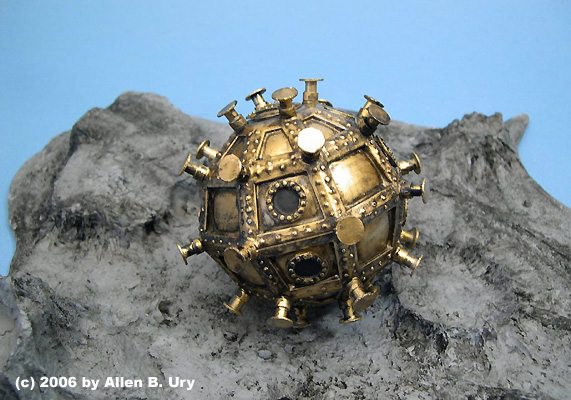
And another view of this model…
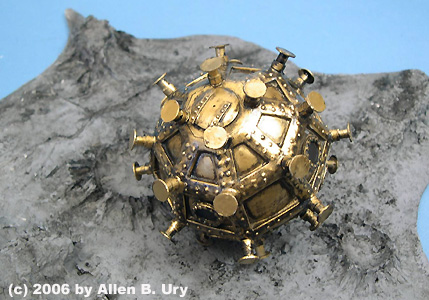
Dynamation!
Special effects artist Ray Harryhausen will be forever remembered for the magical fighting skeletons seen in both Nathan Juran‘s inspired fantasy The 7th Voyage Of Sinbad (1958) and in Don Chaffey‘s Jason And The Argonauts (1963). Harryhausen animated the skeletons with his own variation on the stop-motion technique – Dynamation – with which he recreated scenes that a child of the fifties or sixties might well have been able to imagine (thanks to comics) but would have never dreamed of actually seeing such scenes re-enacted on the big silvery screen. Despite all the advancements made by modern computer and digital technology, Harryhausen’s effects still impress us, largely because they were always based on a resolutely human scale and were, as such, always believable. His extensive career also includes The Beast From 20,000 Fathoms (1953), The Three Worlds Of Gulliver (1960), One Million Years BC (1967), and Clash Of The Titans (1981). -Horrornews
The real reason to check out The First Men in the Moon is Ray Harryhausen, the visual effects maestro who advanced stop motion animation, (here called “Dynamation”) always used to an impressive result.
He was a true pioneer and this film (his tenth) had him at his best.
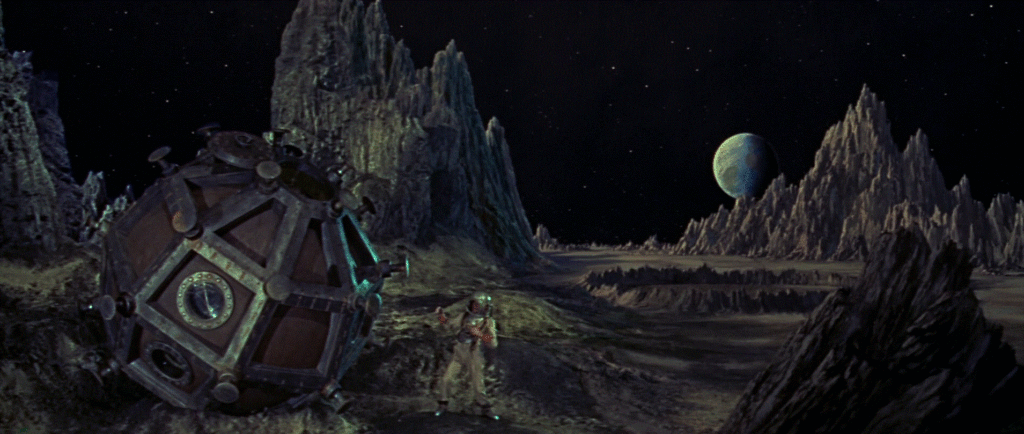
Even though the first half of the movie has a serious drag issue, once the trio actually gets to the moon, it becomes a fun little romp.
The acting is good.
Judd, Jeffries and Hyer play off each other well in their respective roles. Jeffries’s eccentric scientist Joseph Cavor can be seen as an early precursor of Back to the Future’s Doc. Brown.
Lionel Jeffries should really be a household name, in my humble opinion.
Wait, you’ve never heard of Lionel Jeffries? You’ll most likely recognize his voice from the late 70s BBC children’s series Wombling Free, as the voice of Womble. Oh, wait, you don’t know that one?
How about the mid-sixties British comedy The Spy with a Cold Nose?
No?
Okay, I give up.
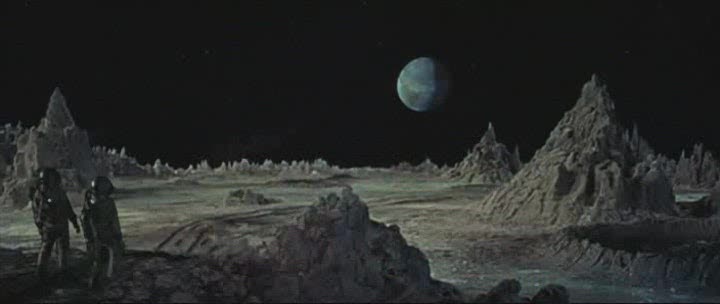
If you can get past the rather slow first half of this film, it gets pretty fun.
It’s a romance disguised as a piece of science fiction, reminding us that audiences tend to not care about the plot or MacGuffins, but instead, the relationships.
It’s a tiny little gem, coming off the heels of Journey to the Center of the Earth, and worth watching for Harryhausen’s special effects and for Lionel Jeffries charming performance.
Further enjoyments
Ray Harryhausen’s other films are:– the atomic dinosaur film The Beast from 20,000 Fathoms (1953); the giant atomic octopus film It Came from Beneath the Sea (1955); the alien invader film Earth Vs. The Flying Saucers (1956); the alien monster film 20 Million Miles to Earth (1957); The 7th Voyage of Sinbad (1958); The 3 Worlds of Gulliver (1960); the Jules Verne adaptation Mysterious Island (1961); the Greek myth adventure Jason and the Argonauts (1963); the caveman vs dinosaurs epic One Million Years B.C. (1966); the dinosaur film The Valley of Gwangi (1969); the two Sinbad sequels The Golden Voyage of Sinbad (1973) and Sinbad and the Eye of the Tiger (1977); and the Greek myth adventure Clash of the Titans (1981).
Nathan Juran’s other films are:– the historical horror film The Black Castle (1952), the giant bug film The Deadly Mantis (1957), Harryhausen’s 20 Million Miles to Earth (1957), the classic bad films The Brain from Planet Arous (1957) and Attack of the 50 Foot Woman (1958), Harryhausen’s The 7th Voyage of Sinbad (1958), Jack the Giant Killer (1962) and The Boy Who Cried Werewolf (1973).
All of which are excellent flicks to watch while you are bored waiting for the “all clear” horn to sound and you all can get out of your “fallout shelters”.
Conclusion
It’s a charming movie that has the ability to whisk you away towards simpler times. That, my friends, is something that we truly need today.
Hey! If you enjoyed this post, then you would love my index. Check out my Movie index here…
MOVIESArticles & Links
You’ll not find any big banners or popups here talking about cookies and privacy notices. There are no ads on this site (aside from the hosting ads – a necessary evil). Functionally and fundamentally, I just don’t make money off of this blog. It is NOT monetized. Finally, I don’t track you because I just don’t care to.
- You can start reading the articles by going HERE.
- You can visit the Index Page HERE to explore by article subject.
- You can also ask the author some questions. You can go HERE to find out how to go about this.
- You can find out more about the author HERE.
- If you have concerns or complaints, you can go HERE.
- If you want to make a donation, you can go HERE.

